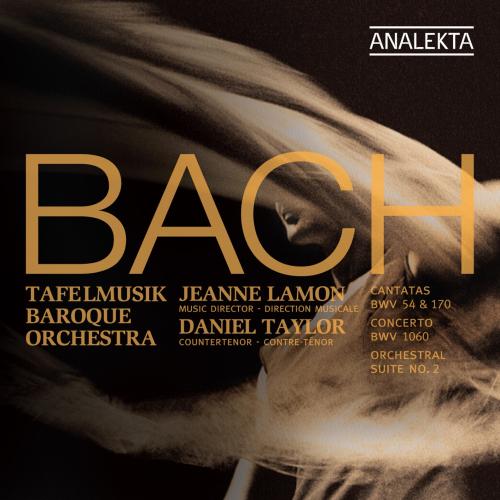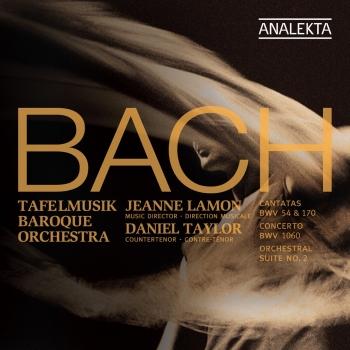
J.S. Bach: Cantatas BWV 70 & 154; Concerto BWV 1060; Orchestral Suite No. 2 Daniel Taylor, Tafelmusik Baroque Orchestra & Jeanne Lamon
Album Info
Album Veröffentlichung:
2011
HRA-Veröffentlichung:
28.11.2019
Label: Analekta
Genre: Classical
Subgenre: Vocal
Interpret: Daniel Taylor, Tafelmusik Baroque Orchestra & Jeanne Lamon
Komponist: Johann Sebastian Bach (1685–1750)
Das Album enthält Albumcover
- Johann Sebastian Bach (1685 - 1750): Cantata "Vergnugte Ruh, beliebte Seelenlust" BWV 170:
- 1 Cantata "Vergnugte Ruh, beliebte Seelenlust" BWV 170: I. Aria: Vergnugte Ruh, beliebte Seelenlust 06:46
- 2 Cantata "Vergnugte Ruh, beliebte Seelenlust" BWV 170: II. Recitative: Die Welt, das Sündenhaus 01:19
- 3 Cantata "Vergnugte Ruh, beliebte Seelenlust" BWV 170: III. Aria: Wie jammern mich doch die verkehrten Herzen 07:33
- 4 Cantata "Vergnugte Ruh, beliebte Seelenlust" BWV 170: IV. Recitative: Wer sollte sich demnach 01:18
- 5 Cantata "Vergnugte Ruh, beliebte Seelenlust" BWV 170: V. Aria: Mir ekelt mehr zu leben 05:52
- Orchestral Suite No. 2 (Overture) in A Minor, After BWV 1067 in B Minor:
- 6 Orchestral Suite No. 2 (Overture) in A Minor, After BWV 1067 in B Minor: I. Ouverture 06:36
- 7 Orchestral Suite No. 2 (Overture) in A Minor, After BWV 1067 in B Minor: II. Rondeau 01:52
- 8 Orchestral Suite No. 2 (Overture) in A Minor, After BWV 1067 in B Minor: III. Sarabande 03:18
- 9 Orchestral Suite No. 2 (Overture) in A Minor, After BWV 1067 in B Minor: IV. Bourrée I & II 01:48
- 10 Orchestral Suite No. 2 (Overture) in A Minor, After BWV 1067 in B Minor: V. Polonaise 03:07
- 11 Orchestral Suite No. 2 (Overture) in A Minor, After BWV 1067 in B Minor: VI. Menuet 01:11
- 12 Orchestral Suite No. 2 (Overture) in A Minor, After BWV 1067 in B Minor: VII. Badinerie 01:32
- Cantata "Widerstehe doch der Sünde", BWV 54:
- 13 Cantata "Widerstehe doch der Sünde", BWV 54: I. Aria: Widerstehe doch der Sunde 08:50
- 14 Cantata "Widerstehe doch der Sünde", BWV 54: II. Recitative: Die Art verruchter Sünden 01:14
- 15 Cantata "Widerstehe doch der Sünde", BWV 54: III. Aria: Wer Sünde tut, der ist vom Teufel 03:07
- Concerto in C Minor for Violin and Oboe After BWV 1060:
- 16 Concerto in C Minor for Violin and Oboe After BWV 1060: I. Allegro (44.1kHz) 05:08
- 17 Concerto in C Minor for Violin and Oboe After BWV 1060: II. Adagio (44.1kHz) 04:44
- 18 Concerto in C Minor for Violin and Oboe After BWV 1060: III. Allegro (44.1kHz) 03:32
Info zu J.S. Bach: Cantatas BWV 70 & 154; Concerto BWV 1060; Orchestral Suite No. 2
Johann Sebastian Bach composed a dozen church cantatas for a single solo voice, including four for alto: BWV 54, 170, 35 and 169. Cantatas 54 and 170 are both settings of texts by the Darmstadt court poet, Georg Christian Lehms, from his 1711 cycle of cantata texts, Gottgefälliges Kirchen-Opffer. Cantata 54 is a setting of the text “Widerstehe doch der Sünde,” (Resist to sin) reminding the listener of the dangers of sin. It is one of Bach’s early cantatas, composed in Weimar, where Bach was employed as court organist and chamber musician. It is scored for an ensemble of two violins, two violas and continuo, used by Bach to create a wonderfully rich sound in the opening aria, featuring an astonishingly sinful opening chord. The final aria is a fugue with a chromatic subject, rigorously exhorting the listener to remain steadfast.
Cantata 170 dates from Bach’s third annual cycle of cantatas written as Kapellmeister of the Thomaskirche in Leipzig, and was first performed on the sixth Sunday after Trinity (July 28) in 1726. It is the first in a series of cantatas written at this time that feature the organ in a solo role, written perhaps for Bach’s eldest son, Wilhelm Friedemann, or possibly played by the composer himself. The cantata opens with a beautiful aria in a lilting 12/8, depicting the “delightful rest” to be found in the “concord of Heaven.” A recitative leads to a convoluted aria in which the solo organ and singer are accompanied not by the continuo, but by violins and viola playing the bass line in unison. The twisting, chromatic lines of the organ are interrupted by bursts of elaborate figuration by both the organ and voice at the texts “wenn sie sich nur an Rach und Haß erfreun” (when they rejoice only in vengeance and hate) and “so frech verlacht” (so boldly scorn). The final aria offers delight in the prospect of leaving the world behind, with an almost giddy organ obbligato. The cantata would have been played on the large church organ at St. Thomas’s, and the second aria is specifically written to be played on two manuals, with numerous hand-crossings. We did not have access to a baroque church organ for this recording, but were fortunate to have use of a beautiful portative organ built by Toronto organ builder Thomas Linken, and have adapted the hand-crossings to make them playable on a single manual.
Among Bach’s instrumental works are several that attest to his frequent re-use of entire works in different settings, adapting them to circumstances. Violin concertos were turned into harpsichord concertos, and cantata sinfonias were re-worked as instrumental concertos. The clues Bach left in his own transcriptions and borrowings have fortunately enabled later generations of musicians to reconstruct lost works and to increase, at least on a small scale, his frustratingly small orchestral output. One of the most popular reconstructions is the Concerto for Oboe and Violin, which is a transcription of Bach’s Concerto for Two Harpsichords in C Minor, BWV 1060. The latter is one of three extant double-harpsichord concertos, one of which also survives in a version for two violins (the famous Concerto for Two Violins in D Minor, BWV 1049), presumed to precede the two-harpsichord version. Basing their work on this model, musicologists and musicians set about restoring the presumably lost predecessor to the Concerto in C Minor, BWV 1060. The contrasting nature of the two solo harpsichord parts leads one to assume that the original was scored for two different solo instruments, and details of figuration and range point to an oboe and violin as the logical candidates. The music publisher Breitkopf’s catalogue for the year 1764 lists a concerto by Bach for “Oboe concert. Violino conc. 2 Violini, Viola, Basso,” quite possibly a reference to the C-Minor concerto in its original form.
Like the concertos, Bach’s four extant orchestral suites have an interesting history. The musicologist Joshua Rifkin has done an extensive study of the surviving sources of the suites and has concluded that the Second, Third and Fourth Suites as we know them today are re-workings of earlier works. In the case of the Second Suite, it is clear from studying the surviving manuscript parts that it existed first in A Minor, a tone lower than the extant version in B Minor. The latter is scored for solo flute and strings, but the flute is precluded in the A-Minor version because it falls out of the range of the instrument. Rifkin has concluded that the original probably featured a solo violin in place of the flute, and that it may well have been inspired by a similar suite for violin and strings by J.S. Bach’s cousin, Johann Bernhard Bach, the score of which was in Bach’s library. The suite is the most French in style of the four and the only one that features a solo instrument.
Daniel Taylor, countertenor
John Abberger, oboe
Jeanne Lamon, violin
Tafelmusik Baroque Orchestra
Jeanne Lamon, conductor
Daniel Taylor
is one of the most sought-after countertenors in the world. He appears on more than 100 recordings. Mr. Taylor has performed with the New York Metropolitan Opera, Glyndebourne, Rome, San Francisco, Welsh National, Montreal, and Canadian Opera; at the Edinburgh Festival and at the Royal Albert Hall/BBC Proms. He recently took a role in the world premiere of the Robert Lepage staging of Thomas Adès’s The Tempest. He works with the Tonhalle Zurich, Toronto, Gothenburg, Rotterdam, St. Louis, and Cleveland orchestras. In recital, he has sung at Wigmore Hall, Carnegie Hall, in Beijing, Barcelona, and across North America. He sang on Parliament Hill for Queen Elizabeth and the Prime Minister of Canada.
Mr. Taylor is a professor of voice and opera and head of Historical Performance at the University of Toronto, visiting faculty at the Victoria Conservatory of Music, and a visiting artist at the University of Vienna. He is artistic director and conductor of the choir and orchestra of the Theatre of Early Music, which performs more than 30 concerts every year in concert halls all over the world. He is also artistic director of the new professional ensemble The Trinity Choir, whose second critically acclaimed recording The Tree of Life was released in 2016. Having recently turned his attention to conducting, he was the first guest conductor in the history of the Tallis Scholars. He has also made his debuts with the Kammerchor Stuttgart and the Gabrieli Consort. In 2013, Prof. Taylor was awarded the Queen’s Diamond Jubilee Medal by the Governor General for his work in charity and cultural development in Canada. His recent recording with actor Jeremy Irons won a Grammy.
Dieses Album enthält kein Booklet










